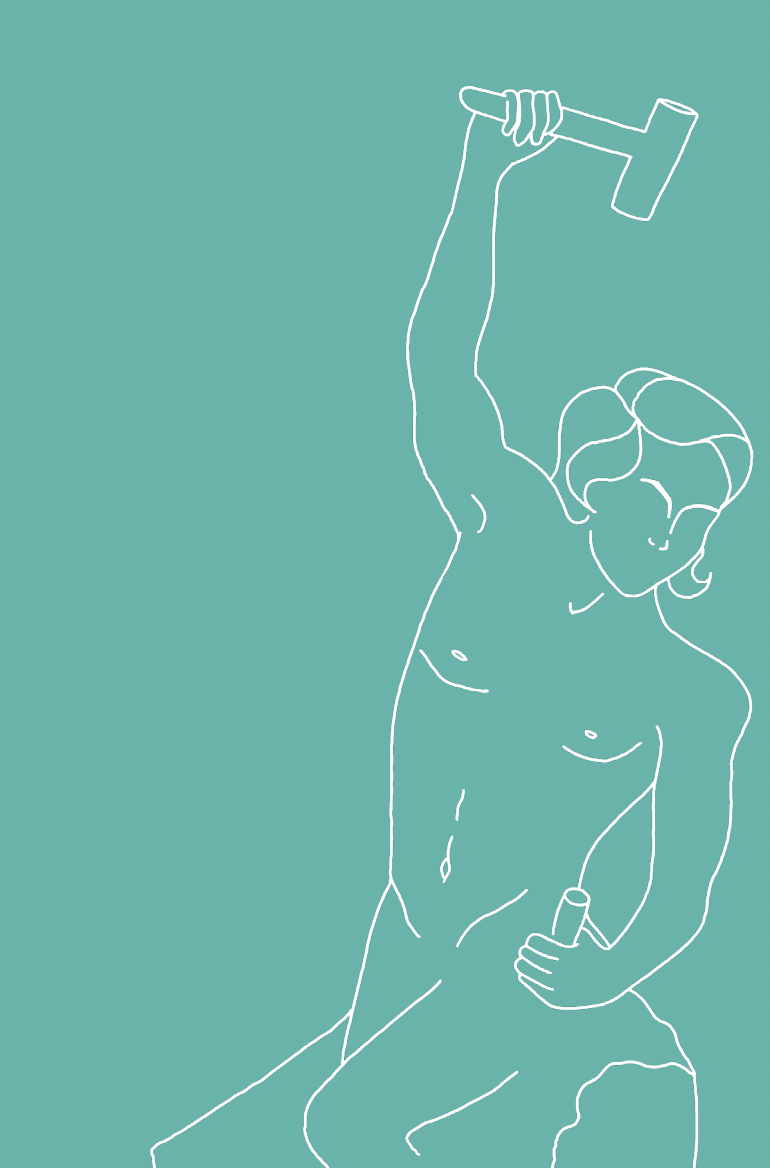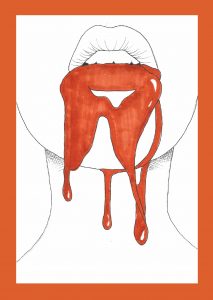
Constructing Transness
by Syni Stamouli | April 4, 2023
I’m scrolling through Reddit (strike one). I soon find myself fighting the urge to respond to every comment written by cis people who just can’t understand (strike two). “I wanted to play with boy’s toys, so I did – it doesn’t mean I’m a boy!” I keep scrolling. “I don’t feel like a woman, I just am one!” There’s a way in which I can’t even blame them; they’ve taken on the narrative that they were supposed to (unable or unwilling to comprehend much else), even when many of the trans people using it didn’t believe it themselves. For every poster-child trans woman who was caught trying on her mother’s heels as a toddler, there are five who tried to bury dysphoria under a John Lennon beard and a four-plate barbell. Yet, this superficial understanding by such quasi-liberals of ‘gender as a social construct’ stops them from being on board with the whole ‘born in the wrong body’ thing. The fact that this manifests as getting off the bus somewhere along a motorway, rather than journeying to a place more developed, is the problem we’re dealing with now.
Part of this comes from the fact that it’s gender we’re talking about. At least straight people know what attraction to people feels like – not to the same sex, sure, but they can still fundamentally comprehend LGB people. But gender? “They hardly know’er!” (strike three). Many cis people will deny it even exists. It is a refusal as infuriating as Margaret Thatcher claiming, “there’s no such thing as society,” and even more comically baffling. One wonders if, in this world, Shania Twain was referring to menstrual cramps, and scientists anticipate discovering the raucous rituals of ‘stag dos’ inscribed on the Y-chromosome. Yet, even those who accept gender roles as a social construct often have difficulty grasping transness – the idea that someone might not in some important way identify with, feel like, and even be, the gender they were assigned at birth. Cis people have varying experiences of feeling like a man or woman, but what is universal is the experience of being one. Society constructs gender as a categorical identifier: it is something that someone simply is or is not, like being human. It is not a matter of subjective identity or desire.
This instinctive common sense becomes the default position on the topic. As with all increasingly visible and intensely political topics, everyone must have an opinion, whilst anyone going against common sense better have a good reason. And as any decent lawyer knows, the narrative is as important as the evidence. Transition lowers suicide rates and has some of the lowest regret rates of all surgeries, which is great and all, but without a convincing story, the most the empirical evidence justifies is a pitiful pantomime that one might act out for an elderly relative losing their memory. Transness, not being part of the structure of society, is bound to narratives from the beginning – narratives which can both render the concept itself and justify its existence in the abstract, as well as serve the material needs of trans people.
This is why the idea of being ‘born in the wrong body’ became widespread; it was a way that trans people could be conceptualised and accepted by Western medical professionals of the 19th and 20th centuries. For trans people to fit into the concept of gender being something that you just are, there must also be some significant part of them that just is a man or woman. This narrative also has a psychological draw. Trans people exist in a cis-centric society and are not immune to its ideology; being ‘born in the wrong body’ is a narrative through which we can understand ourselves and justify our feelings and desires. They are important, then, in pointing to something that is essentially true: we are what we say we are. This isn’t to say that there was any universal consensus or experience amongst trans people at the time regarding this narrative and its implications. Rather, its structure both reflects and informs how we think and continue to think of gender and transition. It holds that everyone is either a man or woman, and that being a particular gender is a matter of what one simply is or is not. Trans people must be wrong in some way, and this wrongness is what legitimises transition. This is inherently pathologising, but in the context of the 20th century, when psychiatrists were diagnosing people with the ‘sexual deviation’ of ‘transvestism’, a pathologisation at the level of the body was better than one of the mind. At least with transness conceived as an intersex condition, neither the body nor brain are internally sick – they are simply wrong for each other. And so, this was seen as the most viable option for much of modern trans history in the West.
This is the all-too-familiar path of queer people buying into acceptance with self-denouncement. In the same way that gay and bisexual people defended their lifestyles by arguing that they were born this way, and so couldn’t help their ‘filthy’ habits, trans people defended themselves by implicitly arguing that they too recognised there was something wrong with them. They were just as disgusted as cis society was by their body, by how it fit into the clothes they wanted to wear, and into the roles they wanted to fill. It’s straightforward to see how this might have had an ever-so-slight impact on how trans people experienced themselves (under the weight of all that soul-guttering dysphoria, of course). Transition was allowed as a Band-Aid to the tragic entrapment of a male/female brain in the existential prison of a female/male body, only as an attempt to change the body to closely resemble that of the opposite sex. As such, a person could live as a ‘proper’ man or woman ought to. When both the best and worst case scenario for binary, gender-conforming trans people was to be viewed as an intrinsically malformed object of pity, there weren’t many other viable options.
And so many have tried to move on from that. Most trans people will say, and even believe, that you don’t need to fit into the ‘born in the wrong body’ archetype to be trans. Yet, leaving this behind means losing the validation of a medical model and its scientific appeal. A new reason must be found for why we feel the way we do, and most importantly, a reason for why it is logically right for trans people to want to transition and be treated as their identified gender. The hole left by a denounced aetiology was stuffed with other theories: ‘a man is someone with a male brain’ was out and ‘a man is someone who identifies as a man’ was in. Of course, brittle with the tension of holding gender apart from both gender roles and sex, these theories are as unconvincing to many trans people as they are to transphobes – they function like a sugar-pill placebo given by doctors who forgot that the sweetness would be a giveaway. But if gender is to be distinct from sex, and yet not about conforming to particular gender roles, then what other definition can be given?
This tension is most apparent in the process of gender questioning. Even people who theoretically agree with de-medicalisation will participate in its practices, namely undertaking a clinical dissection of every part of our lives that an elusive gender identity may have touched (read: every part of our lives). Unlike questioning sexuality, whereby the relevant evidence revolves around crushes, drunken kisses, and how many shows you suddenly had the mysterious urge to binge after hearing about a potentially gay subplot, questioning gender leaves nothing out. No action, feeling, or passing thought is off the table, from birth to the present. This can be twofold: either one seeks the validation that their transness isn’t a confused phase but a permanent state – so something real – or desperately looks for evidence that they are in fact cis, and so can be content with their current life without changing anything. In both cases, it is structurally insatiable – whichever direction the questioning follows, it never leads to an answer. Or maybe I’m projecting: my obsessive-compulsive tendencies had me in a counselling office before they ever got me an actual answer on my gender. Regardless, from the countless articles, blog posts, and forum essays from anonymous throwaways, the only common narrative I could find was that I didn’t relate to other people’s stories. The more I collected, the more unintelligible and conflicting they became. Some knew they were a girl since they were three, and the main emotion of their childhood was not dysphoric angst but genuine confusion as to why they were being treated as if they were a boy. For others, they never felt like anything other than their assigned gender at birth, but the thought of transition seemed inexplicably tempting.
After a while, the absurdity of the situation becomes clear. Here are people tormenting themselves over whether or not they are justified in being something that they can’t even define, in order to permit themselves to do what they clearly want to do. The wanting is important; as Andrea Long Chu argues, desire is the engine of transition, despite it not conforming to any moral or political principles. She calls attention to our reluctance to admit the constitutive role of desire in transness, attributing this in large part to how desire implies absence. To want to be a woman implies that you are not one. It is certainly true that we have an emotional interest in denying something which implies that we aren’t what we say we are or want to be. But it’s more than that. Desire is empty – its only truth is itself. ‘I want’ only shows ‘I want’, and there is no logical chain that can get us to ‘I should have’ or ‘I am’ without applying some personal theory. This is the deeper problem with desire – not that it means or implies inconvenient truths, but that it means nothing at all.
It took a while for me to turn such irritation inwards. I thought that I was seeking an answer about my gender, but what would such an answer change? If I found no trace of transness in my childhood (which was less gender non-conforming than that of many cis peers), or if a brain scan showed no difference to that of a cis woman’s, I would not have stopped being trans. I would not have lost the experience of transness, or the unplaceable force driving me to look for answers in the first place. An answer affirming my potential identity would not have changed the nature of my desires, as it would only have helped me permit myself to feel them. I realised that it was only myself who could grant myself this permission – this is the beauty of transness. Whilst the particular words change, the structure of the narratives we contort ourselves to fit are fundamentally the same. A person’s gender is a truth, printed in black and white, and desire is reduced to an annotation, being a mere response to the nature of their identity rather than anything fundamental itself. Rejecting what this inadvertent pathologisation offers us, in Walt Whitman’s words, “the exquisite realisation of health”. In being trans, we are confronted with the absurdity that what we want is unjustifiable to us. It has no value beyond the fact that we want it, but this desire is enough. That isn’t to say that a sense of identity can’t be central to the trans experience, or that it is invalid or unimportant. Rather, it is to say that fulfilling any identity is not what legitimises a desire to transition – that our bodies and transitions are not the site of a cure or correction, but creation.
Words by Syni Stamouli.
Art by Leon Coyle.




